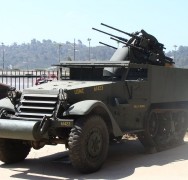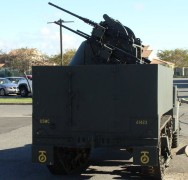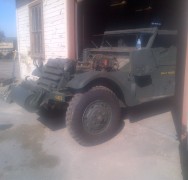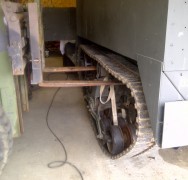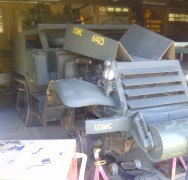M16 Half-Track Multiple Gun Motor Carriage
Between the world wars, the US Army sought to improve the tactical mobility of its forces. With the goal of finding a high-mobility infantry vehicle, the Ordnance Department had evaluated the half-track design by testing French Citroën-Kégresse vehicles. The White Motor Company produced a prototype half track using their own chassis and the body of the M3 Scout Car.
The design, using as many commercial components as possible to improve reliability and speed production, was standardized in 1940 and built by the Autocar Company, Diamond T Motor Company, and the White Company.
Offered with a choice of White 160AX or IHC RED 450 engines, the M3 was driven through a manual constant-mesh (non-synchromesh) transmission with four forward and one reverse gear, as well as a two-speed transfer case. Front suspension was leaf spring, tracks by vertical volute spring. Braking was vacuum-assisted hydraulic, steering manual, without power assist. The electrical system was 12-volt.
The M3 was the larger counterpart to the M2 Half Track Car. The M2 was originally intended to function as an artillery tractor. The M3 had a longer body than the M2 with a single access door in the rear and seating for a 13-man rifle squad. Ten seats were arranged down either side of the vehicle, with three in the cab. Racks under the seats were used for ammunition and rations; additional racks behind the seat backs held the squad’s rifles and other stowage. A small rack for mines was added on the outside of the hull just above the tracks. In combat, most units found it necessary to stow additional food, rucksacks and other crew stowage on the outside of the vehicle. Luggage racks were often added in the field, and very late vehicles had rear-mounted racks for this crew stowage.
Early vehicles had a pintle mount just behind the front seats mounting a .50 caliber (12.7 mm) M2 Browning machine gun. The later M3A1 adopted a raised, armored ‘pulpit mount’ for the .50 caliber, and .30 caliber (7.62 mm) machine guns could be used from mounts along the sides of the passenger compartment. Many M3s were later modified to the M3A1 standard. The body was armored all around with an adjustable armored shutter for the engine’s radiator and a bullet proof windscreen.
Total production of the M3 ran to nearly 41,000 vehicles.
The Mech’s M16A1 is based on the M3 variant. Mounting 4 standard Browning Caliber .50 heavy barrel machine guns, the Quad-50 was primarily an anti-vehicle weapon but, against assaulting infantry, it was a battlefield broom. Selective Fire; recoil operated, air cooled; each gun firing 400-550 710 gr bullets per minute, with an effective range of 2500 yards, it is easy to understand why it was such a fearsome weapon.


